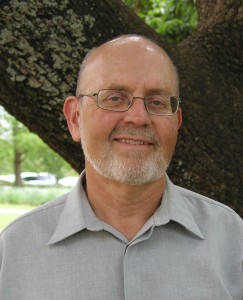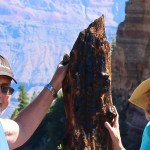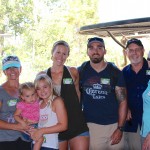Rich
 I spent some of the most enjoyable years of my life earning my M. Phil. and Ph.D. in L. Nicholas Ornston’s laboratory at Yale University. Bruce Ames at U.C. Berkeley and with Herbert Boyer and Howard Goodman at U.C. San Francisco Medical School provided excellent post-doctoral training.
I spent some of the most enjoyable years of my life earning my M. Phil. and Ph.D. in L. Nicholas Ornston’s laboratory at Yale University. Bruce Ames at U.C. Berkeley and with Herbert Boyer and Howard Goodman at U.C. San Francisco Medical School provided excellent post-doctoral training.
I had an exceptional undergraduate experience at the University of Illinois (Champaign), carrying out research with Roderick McCleod and Elie Reichmann and was wisely advised by Judy Willis and David Nanney.
These seven individuals greatly stimulated my love of science and prepared me for a scientific career. They are also responsible for the broad training I received, which has served me well as I have changed my research focus several times.
Since I joined the Genetics Group at the University of Georgia in 1976 and the Genetics Faculty in 1980, I’ve worked in the fields of plant molecular genetics and the plant cytoskeleton, RNA and purine metabolism, phytoremediation, chromatin remodeling, obesity, and most recently cell-type specific epigenetic reprogramming in blood, brain, adipose tissues, and placenta.
My wife Valerie Maples works in a nearby laboratory in the Genetics Department and we’ve really enjoyed raising our family in Athens.
Richard B. Meagher, M.Phil., Ph.D.
Distinguished Research Professor in Genetics Room B402A Davison Life Sciences Bld.
University of Georgia, Athens, GA 30602
meagher@uga.edu
Epigenetic reprogramming in humans and mammalian models in response to environment (e.g., diet, exercise, stress, sleep, carcinogens) and the epigenome induced risk of disease (i.e., cancer, cardiovascular disease, metabolic syndrome, obesity). We have a strong interest in solving the technical issues associated with performing cell-type-specific epigenetic analyses on “difficult” organs including blood, brain, adipose tissues, and the placenta.
2010 to present
Evolution, multigenerational inheritance, and chemical turnover of epigenetic information
2002 to present
Epigenetics and chromatin remodeling machinery as they impact development and reproduction.
1979 to 2014
The plant actin-based cytoskeleton and the evolution of gene families as its contingent relationship to the macroevolution of various plant organs and tissues.
1980 to 2005
Phytoremediation – The theory behind and the engineering of plants that extract and detoxify mercury and arsenic contaminating our soil and water.
1982 to 2000
RNA turnover as it regulates gene expression and light regulated carbon fixation
1969 to 1972
The protein chemistry and evolution of enzymes catabolizing aromatic compounds in bacteria
1967 to 1969
The molecular biology of double stranded RNA viruses replicating in both plant and insect hosts
Richard B. Meagher Distinguished Research Professor in Genetics
A. Publications
Here is Dr. Meagher’s profile at Google Scholar for an updated list of his ~200 reviewed publications starting in 1972
B. Education / Training
| Institution and Location | Degree | Years | Fields of Study |
|---|---|---|---|
| University of Illinois, Champaign, IL | B.S. | 1965-1969 | Biology with Honors, Physical Chemistry |
| Yale University, New Haven, CT | M. Phil. | 1969-1971 | Biology, Biochemistry |
| Yale University, New Haven, CT | Ph.D. | 1971-1973 | Biology, Enzymology |
C. Positions and Honors
C1. Positions
- 1969-1971 – Phil. student in the laboratory of L. Nicholas Ornston at Yale University, Enzymology, Peptide Chemistry, Aromatic metabolism, Biochemical evolution.
- 1971-1973 – D. student in the laboratory of L. Nicholas Ornston at Yale University, Protein chemistry, Gene and protein evolution.
- 1973-1974 – Postdoctoral Fellow in the laboratory of Bruce Ames at University of California, Berkeley, Protein chemistry, Carcinogenesis and Mutagenesis (The Ames’ Test).
- 1974-1976 – Postdoctoral Scholar at the University of California San Francisco, in the laboratories of Herbert Boyer and Howard Goodman, Cloning and expression of plant and fly DNA.
- 1976-1980 – Assistant Professor of Microbiology & Botany, Program of Genetics, University of Georgia
- 1980-1983 – Assistant Professor of Genetics, University of Georgia
- 1983-1988 – Associate Professor of Genetics, University of Georgia
- 1987-1995 – Co-Founder & Director University’s “Molecular Genetics Instrumentation Facility”
- 1985-1989 – Co-Founder & Co-Director to the University’s “Biological Scientists Computational Resource”
- 1988-2006 – Professor of Genetics, University of Georgia
- 1995-1998 – Genetics Department Head, University of Georgia
- 2003-present – Founder and Chief Scientific Officer of Abeome Corporation (Athens, GA)
- 2006-present – Distinguished Research Professor, Genetics Department, University of Georgia
- 2014-present – UGA Research Foundation’s Program Leader for Research on Obesity
C2. Honors (selected)
- 1969-1972 – NIH Pre-doctoral Fellow in Genetics
- 1973-1974 – American Cancer Society Postdoctoral Fellow
- 1974-1976 – NIH Postdoctoral Research Scholar
- 1981 – U.S. News & World Report featured as one of U.S.A.’s “Superachievers”
- 1987 – University of Georgia “Creative Research Award”
- 2001 – University of Georgia “Lamar Dodd Creative Research Award”
- 2004 – University of Georgia “Inventor’s Award” for patents, contributions to the business community
- 2004 – Esquire Magazine’s “America’s Best and Brightest” visionaries, rebels, & leaders
- 2005 – Fellow of The American Association for the Advancement of Science (AAAS)
- 2007 – Research featured on PBS, BBC, National Geographic Special “Strange Days on Planet Earth”
C3. Most recent invited public presentations
- 2014 An INTACT mouse model with affinity tagged adipocyte nuclei for epigenetic studies of obesity. Short talk at the Endocrinology Society Meeting (ICE/ENDO Chicago, IL) about our progress with INTACT “Isolation of Nuclei TAgged in Specific Cell Types” technology in engineered mice. INTACT is another method of using nuclei to perform cell type specific epigenetic studies on a difficult to isolate cell type, adipocytes.
- 2011 The Evolution of Epigenetic Control – Keynote lecture at the annual meeting of the Society for Experimental Biology in Glasgow, Scotland. Invited lecture on work relevant to this application.
- 2011 Actin’s Competence for Spatial Development – Wenner-Gren Foundation Symposium in Stockholm, Sweden. Invited full-length lecture on our research on actin’s common role in development across all four eukaryotic kingdoms.
C4. Contributions to the Advancement of Science
- Associate Director-1987–Plant Molecular Biology Gordon Conference
- Director-1988–Plant Molecular Biology Gordon Conference
- USDA Competitive Grants “Plant Genome” Panel Manager, 1991-92
- Member of NIH “Molecular Biology” Study Section Panel, 1992-96
- Member of NIH “Molecular Cell Biology” Study Section, 1995-97
- Member of U.S. Department of Energy’s “Environmental Management Science Program Review Panel 2000.
- Served on the NIH Postdoctoral Fellows “Cell Biology” Study Section, 2003-2004
- Member of NIH “Postdoctoral Fellow” Study Section, 2003, 2004
- Ad Hoc Member of NIH “Molecular Cell Biology” Study Sections, 2001-2006
- Member of the American Society of Plant Biologists Martin Gibbs Medal Award Committee, 2005 (Five year appointment)
- Served on the NIH “Cell Structure and Function” Study Section, 2005
- Serving as an Adhoc Reviewer for the USDA’s SBIR Phase II Plant Production and Protection Program, 2005
- Reviewed manuscripts recently for: Plant Physiology, Plant Journal, Inter. Plant Cell, Nature Biotechnology, Molecular Biology of the Cell, Molecular Cell, Environmental Science & Technology,
- Reviewed grants for USDA, NSF, DOE and NIH
- Review Board Member for the International Journal of Phytoremediation
- NIH Reviewer for K99 awards – 2011
C5. Service To University of Georgia (Selected Examples)
- Scientific Advisor of the Molecular Genetics Instrumentation Facility for 10 years.
- Scientific Advisor to Research Computational Resource for 8 years.
- Assisted Vice President for Research with UGA’s efforts to develop a biotechnology liaison with Vydehi Institute of BioTech Sciences in India.
- University Review Committee for Promotion and Tenure, Five 3 year appointments.
- Current: Appointed to serve on the University’s Intellectual Property Committee, 2007-present.
- Current: Head of minority recruitment for the Genetics Department
- Current: Program Leader for Research in UGA’s Obesity Initiative
C6. Service to the Community
- Founder or co-founder of biotechnology companies based on RBM’s patents held by UGARF
- Founder of Applied PhytoGenetics, Inc. (APGEN), a phytoremediation company in
- Athens, GA using Dr. Meagher’s UGA patented technologies
- Co-founder of PhyGen, Inc., a phytoremediation company, based in South Korea
- Founder of Abeome, Inc., a company using Dr. Meagher’s UGA patented engineered myelomas and mice to accelerate the production of monoclonal antibodies. Abeome is focused on developing therapeutics for cancer, inflammation, and obesity related health problems.
- Developed a new UGA patented technology for the Athens’ based company, InsectiGen, using engineered plants to produce buoyant Bt toxins that kill mosquito larvae in water.
C7. Consultant to Industry.
- 1976-1999 – Past consultancies lasting more than 3 years. Monsanto, DuPont, American Cyanamide, Dow Chemical. Genetic engineering of plants.
- 2002 to Present – Consultant to Abeome, Corp. Production of therapeutic monoclonal antibodies.
- 2011 to Present – Consultant to Rotam Agrochemical Company, LTD. Genetic modification of plants.
D. Recent Funding
Funding during the last 3 years from a total of ~$18,000,000, while at UGA.
| Year | Amount | Agency | Title |
|---|---|---|---|
| 2012 | $39,891 | NAT INST OF HEALTH SBIR/Sub | Semi-targeted Immuno-Therapeutic Approach to Control Morbid Obesity |
| 2012 | $300,000 | NAT INST OF HEALTH | Affinity Tagging of Adipocyte Nuclei to Examine the Epigenetic Controls of Obesity |
| 2013 | $300,000 | NAT INST OF HEALTH | Affinity Tagging of Adipocyte Nuclei to Examine the Epigenetic Controls of Obesity |
| 2014 | $356,000 | NAT INST OF HEALTH | Nuclear Capture for the Cell-Type Specific Epigenetic Analysis of Adipocytes |
| 2014 | $25,000 | UGA Obesity Initiative | MOUSE XENOGRAFT MODEL FOR HUMAN CELL ADIPOGENESIS |
| 2014 | $25,000 | UGA Obesity Initiative | SLEEP APNEA AND OBESITY EXACERBATE CARDIOVASCULAR DISEASE VIA EPIGENETIC MECHANISMS |
| 2014 | $25,000 | UGA Obesity Initiative | EFFECT OF OBESITY AND FOLIC ACID SUPPLEMENTATION ON GENE-SPECIFIC DNA METHYLATION IN WOMEN OF REPRODUCTIVE AGE: PILOT STUDY |
| 2014 | $25,000 | UGA Obesity Initiative | EXERCISE-INDUCED ADIPOCYTE-SPECIFIC EPIGENETIC REPROGRAMMING IN AN OBESE RAT MODEL |
| 2015 | $75,000 | UGA OVPR IPD | Sleep Apnea and Obesity Exacerbate the Epigenomic Risk of Disease |
| 2015 | $52,000 | UGA OVPR IPD | Effect of maternal obesity on maternal and fetal epigenetic responses to prenatal folic acid doses and impact on early infant growth rate |
| 2015 | $314,000 | NAT INST OF HEALTH | Nuclear Capture for the Cell-Type Specific Epigenetic Analysis of Adipocytes |
| Total | $1,536,891 |
2015 – Understanding Obesity
A UGA produced video in which Rich describes his new approach to the cell type specific analysis of fat cells (adipocytes).
2002 – The phytoremediation of mercury
Segment from National Geographic’s TV series “Strange Days on Planet Earth” Part 4 in which Rich describes his research developing the phytoremediation of environmental mercury. The producers do a nice job of explaining the concept of phytoremediation, even using cartoons to illustrate what goes on in water and soil. Total time 6 minutes: 30 to 36 min of a 54 min video
2002 – The phytoremediation of mercury and Minamata Bay
Segment from Japanese Public Television in which Rich describes his research into the phytoremediation of environmental mercury contamination. The Japanese have a particular interest in the subject because of its relevance to the Minamata Bay mercury poisoning disaster.






